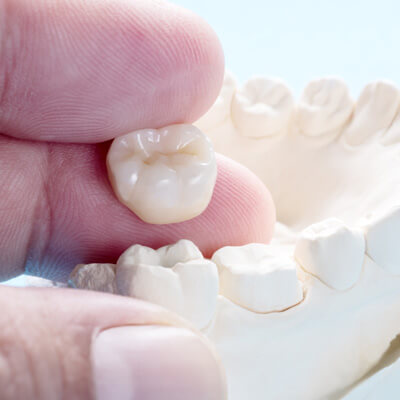Dental Crowns in Brooklyn
 Dental crowns are a way to restore a severely damaged tooth where other methods, such as fillings and inlays, won’t work. The point is to return the tooth to its original shape so it can function as it should. Often referred to as a cap, crowns replace the tooth’s visible part. They are unique to the individual, created from impressions of each person’s tooth.
Dental crowns are a way to restore a severely damaged tooth where other methods, such as fillings and inlays, won’t work. The point is to return the tooth to its original shape so it can function as it should. Often referred to as a cap, crowns replace the tooth’s visible part. They are unique to the individual, created from impressions of each person’s tooth.
Crowns offer protection from infection after root canal surgery, when teeth are discolored, chipped, or broken, or if you grind your teeth, cannot chew food comfortably, or your bite is out of alignment.
Evaluating Patients for Crown Placement
After a complete examination, our dentist evaluates each person as to their suitability for crown placement based on whether the original crown on the tooth is significantly damaged, absent in principle, or has an aesthetic defect. Crowns are not suitable in cases of extreme periodontitis or if the patient is under the age of 14.
Types, Materials, and Manufacturing Methods
Several different materials are used to manufacture crowns. They include
- Metal—the most affordable of all types but the least aesthetic. Their color stands out, and they’re large and shiny.
- Cermet—strong plus with a relatively natural appearance at a low price. They’re made with metal internally and ceramic on the outside. The ceramic part is the same color as natural teeth, but the metal rim becomes noticeable when gums decrease for various reasons.
- Ceramics—don’t contain any metal impurities. They are the most expensive option but are the same color and transparency as natural teeth, providing patients with a beautiful smile.
- Metal-plastic—suitable for temporary crowns, usually with implants.
- Plastic—acrylic or composite resin is used to make a cap.
- Zirconium—closely resembles the texture and appearance of a natural tooth and is stronger than ceramic and porcelain crowns. They also integrate better with the gum and other teeth, making them more popular than other materials.
Choosing What’s Best for You
Contact us to schedule a consultation to see if crowns are a good option for you. We’re here to help you enhance your smile!
CONTACT US
Frequently Asked Questions
What materials are best for dental crowns?
Can a crown be installed without a tooth?
What is better, building up a tooth or installing a crown?

